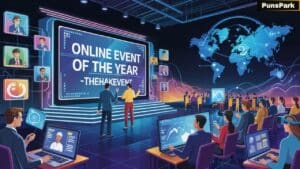Gimkit Host: The classroom has evolved dramatically over the past decade. Gone are the days when teaching meant lecturing while students passively took notes.
Today’s educators need tools that captivate digital natives who’ve grown up with technology at their fingertips. Enter Gimkit – a revolutionary educational game platform that’s changing how teachers engage students and assess learning.
As a Gimkit host, you wield incredible power to transform ordinary lessons into immersive learning experiences. But simply launching a game isn’t enough.
The difference between a forgettable quiz and a transformative learning moment lies in how you leverage the platform’s capabilities.
Recent studies show that gamified learning increases student retention by up to 90% compared to traditional methods.
When students actively participate in their learning through well-designed interactive learning experiences, they’re not just memorizing facts – they’re building deeper connections with the material.
“I’ve seen students who barely speak in class become animated leaders during our Gimkit sessions. The transformation is remarkable.” – Sarah Williams, 8th Grade Science Teacher
This comprehensive guide will equip you with everything you need to become an exceptional Gimkit host who creates memorable learning experiences that students actually look forward to.
Gimkit Fundamentals
What Makes Gimkit Special
While other quiz platforms like Kahoot focus primarily on speed, Gimkit incorporates deeper game dynamics that reward strategic thinking.
The platform’s unique in-game currency system allows students to make meaningful choices that extend beyond simply answering questions quickly.
As a Gimkit host, you’ll appreciate how the platform encourages persistence through failure.
Unlike traditional quiz games where incorrect answers simply result in lower scores, Gimkit’s power-ups and strategic elements give students multiple paths to success.
The platform stands out with its ability to:
- Support multiple game modes that serve different learning objectives
- Allow students to progress at their own pace in many modes
- Provide detailed analytics on student performance
- Integrate seamlessly with existing curriculum materials
- Adapt to various subject areas and grade levels
Core Features Every Host Should Master
Before diving into advanced hosting techniques, ensure you’ve mastered these fundamental features:
| Feature | Teaching Benefit |
|---|---|
| KitCollab | Enables collaborative question creation among teachers |
| Question Bank | Saves time by storing and categorizing questions for reuse |
| Real-time Analytics | Identifies misconceptions immediately during gameplay |
| Custom Theme Creator | Increases engagement through personalized game environments |
| Draw That | Incorporates visual learning elements into questions |
Understanding the psychology behind Gimkit’s effectiveness helps you make better decisions as a Gimkit host.
The platform engages multiple learning modalities simultaneously – visual learners appreciate the colorful interface, kinesthetic learners enjoy the interactive elements, and auditory learners benefit from the discussions that emerge during gameplay.
The Gimkit Host’s Arsenal
Mastering the Host Dashboard
The host dashboard is command central for your Gimkit experience. Many teachers underutilize this powerful interface, missing opportunities to enhance learning.
As an effective Gimkit host, familiarize yourself with these dashboard elements:
- Game Control Panel: Adjust game speed, question timing, and difficulty on the fly
- Student Progress Tracker: Monitor individual and class performance in real-time
- Question Manager: Add, edit, or remove questions during active sessions
- Communication Tools: Send announcements or hints to struggling students
- Analytics Overview: Get instant feedback on class performance patterns
Pro tip: Use the dashboard’s keyboard shortcuts to save precious classroom time. Pressing “P” pauses the game, while “N” advances to the next question – perfect for those teachable moments when you need to clarify a concept.
Hidden Features Most Hosts Miss
Beyond the basics, Gimkit offers several powerful but often overlooked features that can transform your hosting experience:
- Question weighting allows you to assign higher point values to more challenging questions, ensuring that differentiated learning naturally occurs within the same game.
- Custom timer settings for individual questions let you allocate more time for complex problems while keeping simpler recall questions brief and energetic.
- Learning mode temporarily removes competitive elements to focus purely on concept mastery – perfect for introducing new material.
- Audio integration helps you incorporate listening comprehension for language classes or audio cues for students with different learning needs.
- Penalty customization lets you adjust the consequences for incorrect answers based on your specific learning objectives and student confidence levels.
As one middle school teacher noted:
“I discovered I could create question pools that randomly select from similar questions. This dramatically reduced students memorizing answers by position and forced them to actually learn the material.”
Content Creation Strategies
Crafting Questions That Promote Critical Thinking
The questions you create as a Gimkit host determine whether students engage in deep learning or surface-level memorization.
Quiz-based learning is most effective when questions require students to apply knowledge rather than simply recall facts.
Consider these question formats for different thinking levels:
- Remember: “What is the capital of France?”
- Understand: “Why is Paris strategically located as France’s capital?”
- Apply: “How would France’s development have differed if Lyon had been the capital?”
- Analyze: “Compare the development of Paris as a capital city with London.”
- Evaluate: “Assess whether Paris remains the optimal capital location in modern France.”
- Create: “Design an ideal capital city for France based on contemporary needs.”
For math content, structure questions that test conceptual understanding rather than calculation speed. Include visual representations of problems and ask students to identify the correct approach before solving.
In science classes, incorporate image-based questions that ask students to interpret data or predict experimental outcomes. This approach better mirrors authentic scientific thinking than simple terminology questions.
Subject-Specific Approaches That Work
Different subjects benefit from specialized approaches when creating Gimkit content:
Language Arts:
- Include passages with context-dependent vocabulary
- Create question sets around literary devices in context
- Use fill-in-the-blank questions for grammar concepts
- Design sequence questions for plot development
Science:
- Incorporate actual lab data in analysis questions
- Use diagrams that require labeling or process identification
- Create scenarios where students apply scientific principles
- Include questions that address common misconceptions
History:
- Use primary source analysis questions
- Create sequence-based questions for chronological understanding
- Develop comparison questions between historical periods
- Design cause-and-effect relationship questions
Mathematics:
- Include visual representations of concepts
- Create multi-step problems with strategic hints
- Design questions that reveal common calculation errors
- Incorporate real-world applications of abstract concepts
Game Mode Mastery
Selecting the Right Mode for Your Learning Objectives
As a skilled Gimkit host, your choice of game mode should align with specific learning goals. Each mode creates different classroom dynamics and supports particular types of learning.
Classic Mode: Best for individual concept mastery and assessment. Students work independently at their own pace, making this ideal for reviewing material before tests or introducing new concepts where students need time to process information.
Team Mode: Excellent for promoting collaboration and peer teaching. Students work together to answer questions, naturally leading to discussions where stronger students help those who are struggling. This mode develops both content knowledge and interpersonal skills.
Trust No One: Perfect for developing critical thinking and attention to detail. Students must identify correct and incorrect information, encouraging deeper analysis of content rather than surface-level memorization.
Humans vs. Zombies: Creates high energy and works well for quick reviews. The competitive element motivates students who might otherwise disengage, while the team aspect prevents individual students from feeling singled out for incorrect answers.
Match Mode: Ideal for vocabulary development and association-based learning. Students connect related concepts, strengthening neural pathways between ideas.
Custom Mode Creation for Specific Objectives
Advanced Gimkit hosts create custom modes tailored to specific learning objectives:
Concept Progression Mode: Structure questions to build from basic to advanced understanding of a single concept. Start with definition questions, then move to application, and finally to evaluation questions.
Error Analysis Mode: Present common mistakes alongside correct answers, asking students to identify and explain the errors. This develops metacognitive skills and deepens understanding.
Debate Preparation Mode: Include questions that present different perspectives on controversial topics, prompting students to formulate arguments based on evidence.
Procedural Mastery Mode: Break complex procedures into sequential questions that guide students through each step, reinforcing proper technique and sequence.
Real-time Facilitation Techniques
Reading Digital Cues
Effective Gimkit hosts develop the ability to interpret digital signals that indicate student understanding.
While you can’t see puzzled expressions in an online environment, these indicators serve the same purpose:
- Response time patterns: Sudden increases in average answer time often indicate confusion about a particular concept
- Answer distribution: When correct/incorrect responses split evenly, students are likely guessing
- Participation drops: Students who stop answering may be frustrated or confused
- Progress plateaus: Students stuck at certain levels may need intervention
Pro tip: Monitor the chat function for student questions during gameplay.
Designate specific emoji reactions students can use to signal confusion without interrupting the flow.
Intervention Without Breaking Flow
The best classroom activities maintain momentum while addressing learning needs.
When you notice students struggling:
- Targeted hints: Send specific hints to struggling students rather than the entire class
- Strategic pauses: Briefly pause between question sets to clarify frequently missed concepts
- Just-in-time teaching: Address misconceptions immediately after relevant questions
- Progressive scaffolding: Dynamically adjust question difficulty based on performance
- Peer support activation: Pair struggling students with peers who demonstrated mastery
One middle school teacher shares:
“I project the live results on one screen while hosting from another. This lets me quickly identify when most students miss a question and pause for a mini-lesson before moving on.”
Balancing Competition and Collaboration
Healthy competition drives engagement, but excessive competition can undermine learning.
Skilled Gimkit hosts create environments that balance these elements:
- Implement periodic team reshuffling to prevent dominant teams
- Highlight improvement over absolute scores
- Create special recognition for supportive behaviors
- Design challenges that require both individual effort and team coordination
- Share leadership by rotating student roles during sessions
Data-Driven Learning Assessment
Making Sense of Gimkit Analytics
The data generated during Gimkit sessions provides invaluable insights for improving instruction.
As a data-savvy Gimkit host, learn to extract meaningful patterns from these metrics:
Individual Performance Metrics:
- Question-specific accuracy identifies precise learning gaps
- Time-to-answer patterns reveal confidence levels
- Progress trajectories show learning curves
- Power-up usage indicates strategic thinking development
Class-Level Analytics:
- Commonly missed questions highlight curriculum gaps
- Performance clusters reveal differentiation needs
- Engagement patterns show optimal game duration
- Day-to-day comparisons track retention over time
Using Results to Inform Teaching
Transform data into action with these strategies:
- Targeted reteaching: Address specific concepts that data shows were widely misunderstood
- Flexible grouping: Create temporary student groups based on shared misconceptions
- Question refinement: Modify questions that data suggests were unclear or too difficult
- Curriculum pacing: Adjust lesson timing based on mastery evidence rather than predetermined schedules
- Individualized assignments: Assign custom review sessions targeting each student’s specific gaps
Student Growth Through Gimkit
Building Digital Literacy Alongside Content Knowledge
Today’s students need both subject knowledge and technological fluency.
As a thoughtful Gimkit host, you can develop both simultaneously:
- Guide students in creating their own Gimkit questions, teaching both content mastery and digital creation skills
- Discuss strategic approaches to the game, helping students develop decision-making frameworks
- Analyze game results together, building data interpretation abilities
- Troubleshoot technical issues collaboratively, fostering problem-solving skills
Developing Healthy Competition and Sportsmanship
Gamified learning environments provide natural opportunities to develop character alongside content knowledge.
Effective hosts:
- Recognize improvement and effort, not just highest scores
- Create opportunities for students who excel in different aspects (fastest improver, most consistent, best collaborator)
- Facilitate brief reflection discussions about effective strategies
- Model positive responses to both success and setbacks
- Establish clear norms for supportive behavior during gameplay
Shifting from Extrinsic to Intrinsic Motivation
While Gimkit’s points and rewards provide initial motivation, exceptional Gimkit hosts help students develop deeper engagement:
- Gradually shift emphasis from points to knowledge gains
- Connect game content explicitly to real-world applications
- Celebrate moments of conceptual breakthrough alongside game achievements
- Create opportunities for students to teach concepts to peers after mastering them
- Develop metacognitive awareness through reflection questions like “How did this game change your understanding?”
Technical Setup Essentials
Device Compatibility Considerations
A smooth Gimkit experience requires thoughtful technical preparation. Consider these factors:
- Ensure devices have updated browsers (Chrome and Firefox work best)
- Test school Wi-Fi capacity with a small group before full-class implementation
- Prepare offline alternatives for unexpected connectivity issues
- Consider screen size limitations on smaller devices when creating visual content
- Account for typing speed differences between devices (tablets vs. computers)
Classroom Arrangement for Optimal Experiences
Physical setup significantly impacts Gimkit sessions:
Individual Mode Setup:
- Space students to minimize screen viewing by others
- Position yourself where you can scan screens periodically
- Consider headphone use for audio components
Team Mode Setup:
- Arrange desks in pods for team discussions
- Ensure each team has at least one strong reader
- Position team displays to minimize distractions to other groups
Accessibility Considerations:
- Provide larger screens for students with visual impairments
- Consider audio support options for reading-intensive questions
- Adjust timer settings for students who may need extra processing time
Advanced Hosting Tactics
Integrating Gimkit with Broader Curriculum Goals
Exceptional Gimkit hosts see the platform as an integrated component of their curriculum, not an isolated activity:
- Design Gimkit sessions that bridge concepts across units
- Create question progressions that align with curriculum learning trajectories
- Use Gimkit data to inform adjustments to other aspects of instruction
- Integrate Gimkit vocabulary into regular classroom discussions
- Develop consistent question formats that mirror assessment approaches
Creating Themed Learning Journeys
Transform isolated Gimkit sessions into connected learning narratives:
- Develop character or storyline elements that progress across multiple sessions
- Create themed question sets that build toward culminating projects
- Design “level-up” systems where concepts unlock new game experiences
- Implement knowledge-building paths where earlier content forms foundations for later games
- Incorporate subject-appropriate themes that contextualize content (historical periods, scientific expeditions, literary worlds)
Building Student-Created Content
Empower students to become content creators, deepening their understanding while developing 21st-century skills:
- Guide students in researching and creating high-quality questions
- Implement peer review processes for student-created content
- Create special “student expert” Gimkit sessions featuring top student-created questions
- Develop question design rubrics that emphasize cognitive depth
- Allow students to customize game themes aligned with content
Case Studies: Gimkit Success Stories
Elementary Application Breakthroughs
A third-grade teacher transformed math fact fluency by implementing daily 10-minute Gimkit sessions with these adaptations:
- Used the visual question format for students still developing reading skills
- Implemented a “personal best” tracking system to emphasize individual growth
- Created visual rewards that celebrated improvement milestones
- Paired struggling students with “math mentors” during team modes
- Reported a 35% improvement in computational fluency over one semester
Middle School Engagement Transformations
An eighth-grade science teacher revitalized a challenging chemistry unit:
- Developed progressive question sets that built conceptual understanding of atomic structure
- Created visual questions requiring students to interpret models and diagrams
- Implemented team competitions that mixed ability levels
- Used Gimkit data to form flexible lab groups based on conceptual understanding
- Saw participation rates increase from 68% to 97% along with a 22% improvement in unit test scores
High School Critical Thinking Developments
An AP History teacher used Gimkit to develop deeper analytical skills:
- Created questions requiring evidence evaluation and source analysis
- Implemented “perspective challenges” where students answered from historical viewpoints
- Developed thesis assessment questions where students evaluated argument strength
- Used team modes to facilitate debates about historical interpretations
- Reported significant improvement in students’ written arguments and source analysis
FAQs
What is a Gimkit Host, and why is it important in the classroom?
A Gimkit Host is the educator or individual who sets up, manages, and leads a Gimkit game session for students. They are essential in creating an interactive, engaging learning experience by choosing the right quizzes, setting game modes, and fostering a collaborative environment. A Gimkit Host ensures that the game runs smoothly, keeping students engaged and helping them retain what they’ve learned in a fun and competitive setting.
How does a Gimkit Host create effective learning experiences for students?
A Gimkit Host can create effective learning experiences by tailoring quizzes to the class’s needs, using different game modes, and incorporating real-time feedback. By choosing content that aligns with the curriculum and encouraging students to collaborate, a Gimkit Host turns standard review sessions into exciting challenges that enhance learning and student engagement.
Can a Gimkit Host customize quizzes for different subjects?
Absolutely! As a Gimkit Host, you have the flexibility to create quizzes for any subject, from math and science to history and language arts. By customizing the content, a Gimkit Host can ensure that quizzes match the curriculum, challenge students appropriately, and make learning more enjoyable.
What are the benefits of being a Gimkit Host in a classroom setting?
Being a Gimkit Host offers several benefits, such as increased student engagement, the ability to assess learning outcomes in real-time, and fostering collaboration among peers. It encourages students to think critically, communicate with others, and enjoy learning through a competitive game format, all while helping educators identify areas where students might need more support.
How can a Gimkit Host encourage collaboration among students during the game?
A Gimkit Host can encourage collaboration by selecting team-based game modes where students must work together to answer questions. Through discussions and strategy sessions, students learn the value of teamwork and communication, which are essential skills both in and out of the classroom. The role of the Gimkit Host is to promote healthy competition while fostering collaboration.
What are some best practices for a Gimkit Host to follow?
To be an effective Gimkit Host, it’s important to understand your students’ strengths and weaknesses, choose the right game modes for the lesson, and provide timely feedback. Encourage discussion, regularly update quizzes to keep things fresh, and be proactive in monitoring student progress. By following these best practices, a Gimkit Host can create a rewarding and productive learning environment.
Conclusion
Becoming an exceptional Gimkit host is a journey that transforms both teaching and learning.
By thoughtfully implementing the strategies in this guide, you’ll create dynamic learning environments where students eagerly engage with content, develop critical thinking skills, and build positive relationships with both the material and each other.
The future of Gimkit continues to evolve, with new features regularly expanding what’s possible in the classroom.
By joining online Gimkit communities and sharing your own innovations, you’ll stay at the cutting edge of this powerful educational tool.
Remember that your unique teaching style is your greatest asset as a Gimkit host.
The platform provides powerful capabilities, but it’s your pedagogical decisions that transform those features into meaningful learning experiences.
The most successful hosts continuously refine their approach based on student responses and outcomes. Start small, experiment regularly, and collect feedback to develop your personal Gimkit hosting style.
Your journey to becoming an outstanding Gimkit host begins with a single game.
Take what you’ve learned here and transform your next lesson into an unforgettable learning adventure.
Read more knowledgeable blogs on Puns Park

Philipp Engel is a master of wit and wordplay, dedicated to crafting pun-filled content that brings smiles and laughter to readers. With a knack for turning ordinary phrases into extraordinary humor, Philipp shares clever pun guides to brighten your day and sharpen your sense of humor.







